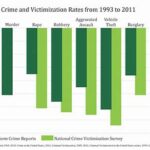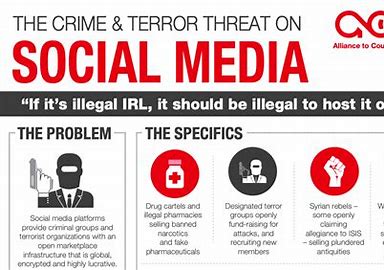Title: Unraveling the Influence of Social Media on Crime in the United States: Trends, Impacts, and Responses
Abstract:
Social media platforms have transformed the landscape of communication, connectivity, and information dissemination, offering unprecedented opportunities for interaction and engagement. However, alongside the benefits, social media has also been implicated in facilitating and perpetuating various forms of crime in the United States. From cyberbullying and online harassment to the spread of extremist ideologies and the organization of criminal activities, social media influences crime in multifaceted ways. This essay provides an in-depth analysis of the influence of social media on crime in the United States, examining trends, impacts, and responses to this complex phenomenon. Drawing on empirical research, case studies, and expert insights, it explores the role of social media in shaping criminal behavior, its impact on law enforcement and justice systems, and the challenges and opportunities for addressing social media-related crime in contemporary society.

Introduction:
Social media has emerged as a ubiquitous presence in modern society, transforming the way people communicate, interact, and share information. With billions of users worldwide, platforms such as Facebook, Twitter, Instagram, and TikTok have become integral parts of daily life, influencing social norms, cultural practices, and political discourse. However, the rise of social media has also been accompanied by concerns about its role in facilitating and perpetuating various forms of crime. In the United States, where rates of cybercrime, online harassment, and digital extremism are on the rise, understanding the influence of social media on crime is essential for developing effective strategies to address these challenges. This essay aims to provide a comprehensive examination of the influence of social media on crime in the United States, exploring trends, impacts, and responses to this complex and evolving phenomenon.
Trends in Social Media-Related Crime:
Social media has been implicated in a wide range of criminal activities in the United States, reflecting the diverse ways in which digital platforms are used to facilitate and perpetrate unlawful behavior. Some key trends in social media-related crime include:
Cyberbullying and Online Harassment:
Social media platforms provide fertile ground for cyberbullying and online harassment, allowing perpetrators to target victims anonymously or under pseudonyms and to disseminate harmful or abusive content to a wide audience. Cyberbullying can take various forms, including harassing messages, explicit images, and threats of violence, and can have serious consequences for victims’ mental health and well-being.
Digital Extremism and Radicalization:
Social media platforms have become key battlegrounds for the spread of extremist ideologies, hate speech, and radicalization narratives. Extremist groups and individuals use social media to recruit followers, disseminate propaganda, and coordinate activities, posing significant challenges for law enforcement and counterterrorism efforts.
 Online Fraud and Financial Crimes:Social media platforms are increasingly used to perpetrate online fraud schemes, including identity theft, phishing scams, and fraudulent sales and investment schemes. Criminals exploit the anonymity and reach of social media to target unsuspecting victims and defraud them of money and sensitive information.
Online Fraud and Financial Crimes:Social media platforms are increasingly used to perpetrate online fraud schemes, including identity theft, phishing scams, and fraudulent sales and investment schemes. Criminals exploit the anonymity and reach of social media to target unsuspecting victims and defraud them of money and sensitive information.
Child Exploitation and Online Predation:
Social media platforms have been implicated in facilitating child exploitation and online predation, allowing predators to groom and manipulate vulnerable children and adolescents for sexual exploitation. Online platforms are used to exchange child sexual abuse material, arrange meetings with minors, and facilitate the trafficking of children for sexual purposes.
Cyberstalking and Privacy Violations:
Social media enables perpetrators to engage in cyberstalking and privacy violations, allowing them to monitor, track, and harass victims online. Perpetrators may use social media to gather personal information about their victims, monitor their activities, and invade their privacy through unauthorized access to accounts and devices.
Impacts of Social Media-Related Crime:
Social media-related crime has profound impacts on individuals, communities, and society as a whole, shaping perceptions of safety, trust, and security in digital spaces. Some key impacts of social media-related crime include:
Psychological Harm and Trauma:
Victims of social media-related crime may experience significant psychological harm and trauma, including anxiety, depression, and post-traumatic stress disorder (PTSD). Cyberbullying, online harassment, and digital abuse can have long-lasting effects on victims’ mental health and well-being, leading to feelings of isolation, shame, and helplessness.
Erosion of Trust and SafetySocial media-related crime erodes trust and safety in digital spaces, undermining confidence in the security and integrity of online platforms. Fear of cyberbullying, online harassment, and digital exploitation can deter individuals from engaging in online communication and sharing personal information, limiting their participation in digital communities and networks.
Legal and Regulatory Challenges:
Social media-related crime poses significant legal and regulatory challenges for law enforcement agencies, policymakers, and digital platforms. The global nature of social media complicates efforts to investigate and prosecute online offenses, requiring coordination and cooperation among multiple jurisdictions and stakeholders.
Social Division and Polarization:
Social media-related crime contributes to social division and polarization, fostering distrust, hostility, and resentment among different groups and communities. The spread of extremist ideologies, hate speech, and disinformation on social media exacerbates existing social tensions and undermines efforts to promote tolerance, diversity, and inclusion.
Economic Costs and Losses:
Social media-related crime imposes significant economic costs and losses on individuals, businesses, and society as a whole. Online fraud, identity theft, and financial scams result in financial losses, damage to reputation, and disruption of economic activities, undermining consumer confidence and trust in digital transactions.
Responses to Social Media-Related Crime:
Addressing social media-related crime requires a multi-faceted approach that combines prevention, intervention, and enforcement strategies at the individual, community, and societal levels. Some key responses to social media-related crime include:

Education and Awareness:
Promoting education and awareness about the risks and consequences of social media-related crime, including cyberbullying, online harassment, and digital exploitation. Providing resources, training, and support to individuals, families, and communities can help empower them to recognize and respond to online threats effectively.
Digital Literacy and Media Literacy:
Enhancing digital literacy and media literacy skills among users of social media platforms, including children, adolescents, and adults. Teaching critical thinking, information evaluation, and online safety skills can help individuals navigate digital environments responsibly and mitigate the risks of social media-related crime.
Community Engagement and Empowerment:
Engaging communities and stakeholders in efforts to prevent and address social media-related crime, including law enforcement agencies, educators, parents, and civil society organizations. Building partnerships, fostering dialogue, and mobilizing resources can help empower communities to address online threats collaboratively and proactively.
Regulatory Measures and Policy Interventions:
Implementing regulatory measures and policy interventions to address social media-related crime, including legislation, regulations, and guidelines governing online behavior and content. Enhancing accountability, transparency, and oversight of social media platforms can help mitigate the risks of online abuse, exploitation, and radicalization.
Law Enforcement and Legal Remedies:
Strengthening law enforcement capabilities and legal remedies to combat social media-related crime, including investigation, prosecution, and deterrence strategies. Providing training, resources, and support to law enforcement agencies can enhance their capacity to respond effectively to online offenses and hold perpetrators accountable for their actions.

Conclusion:
Social media has transformed the way people communicate, connect, and share information, offering unprecedented opportunities for interaction and engagement. However, alongside the benefits, social media has also been implicated in facilitating and perpetuating various forms of crime in the United States. From cyberbullying and online harassment to digital extremism and financial fraud, social media-related crime presents complex challenges that require comprehensive responses at multiple levels. By understanding the trends, impacts, and responses to social media-related crime, stakeholders can work together to promote a safer, more secure, and more inclusive digital environment for all. Only through collective action and collaboration can society effectively address the risks and vulnerabilities associated with social media and harness its potential for positive social change and empowerment.




